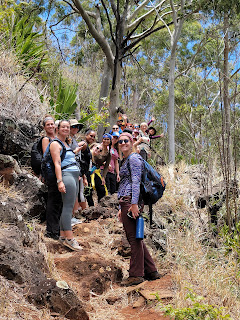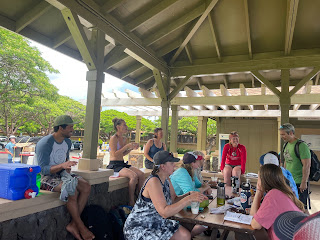Day 1
We arrived at camp site Olowalu at 4PM which is located on the western shore of the island of Maui. We set up our tents just a few feet from the beach, allowing us to fall asleep each night to the sounds of the waves crashing on the shore, and then set up camp and got to work on cooking our first dinner together. We were also met by the lively wild chickens that live at the campground - the roosters loved to wake us up every morning at 4:15 AM and they all had the best time trying to get into the foods we prepared! We even named one – NACHO!!!!
For our first day of Conservation work we drove to Mt Haleakala in Haleakala National Park after
breakfast at the camp. We hiked up part of the mountain most visitors usually do not have access to
and ate our pack lunch on the mountain side.
Day 3
This was the first of three days we got to work with Edwin “Ekolu” Lindsey III, the president of the
Maui Cultural Lands. The conservation nonprofit had been started by his parents and Ekolu took over
in 2009. He welcomed us into the Honokowai Valley, and then led us in a Mele, a chant to the elders
and the place to ask for permission to do the work of the day. You can watch a Ted Talk from Ekolu
about his kuleana, or responsibility to take care of the environment, here.Ekolu taught us about the Hawaiian concept of Mauka to Makai - taking care of the land from
mountain to ocean.
This is one of the areas we cleared!
After work Ekolu took us on a tour the preserve and introduced us to the wiliwili tree, Erythrina
sandwicensis, which is a flowering tree in the pea family Fabaceae and is the only indigenous Hawaiian
wiliwili. It is also one of the few deciduous trees on the island. Its bark is light (as you can see from
picture below) and buoyant and so large trunks are used to shape the papa he‘e nalu (surfboards) ridden
by the island’s ali‘i (chief) and to make part of the canoes. Smaller pieces were used for the floats on
fishing nets. Ash from burnt wood was used as a dye, and the kahuna la‘au lapa‘au brewed a potion
from the flowers of the wiliwili to treat diseases.
After the hard work we headed to a beach pavilion for a lesson on coral biology and some free time
to go in the water or shop the local market.
On our second day with Ekolu were traveled to his home, which has been in his family for 4 generations
and where he is the last native Hawaiin to still live on Kahekali Beach. We were split into 2 groups that
roasted through a microplastics in the ocean lesson. The plastics you see in the picture below were all
collected in a 30 minute period from the bay not far from the house.
Ekolu also led us on a walking tour on the beach. Ekolu told us of his efforts to partner with the other
owners and the beach front hotel to protect the corals right outside their homes by acquiring a
conservation status as a naive coastline. He pointed out to us the native grassses growing along
the properties perimeter that works to control soil erosion and protect the land from storm surges.
Once we cycled through the 2 lessons we all got on our snorkel gear and went out into the water to
complete a coral fish survey - armed with our water safe pens and pencils and our fish ID cards we
spent 30 minutes logging the different fish and marine organisms we saw among the dying corals.
We then said our goodbyes to Ekolu and his mother, who had sung for us after lunch, and headed
to town for some shave ice and dinner with a view!
Here we saw the Banyan Tree, in Lāhainā Banyan Court.
Information below found here: In front of the courthouse in downtown Lahaina is a Baynan tree one quarter of a mile in circumference planted on April 24, 1873, to honor the 50th anniversary of the first Protestant mission in Lahaina, which was started at the request of Queen Keōpūolani, the sacred wife and widow of King Kamehameha. At the time it was only eight feet tall.
On our third and final day of work with Ekolu we traveled across the street from our Camp Site to
Kipuka Olowalu (The Olowalu Cultural Reserve) located in the breathtaking Olowalu Valley.
Here, once again we were given the tools needed to cut down invasive trees to help the the restoration
of the native canopy of the forest.
After the hard work was done, we moved further into the preserve to meet Kipula, who showed us the work being done to restore the native taro cultivation. We also visited a site that had previously been cleared and had been planted with a variety of native species.
Day 6
On this day we were all excited to wake early and head to Honolue Bay for a morning of snorkeling
at a healthy coral reef. After a week of hard work this was our time to relax and appreciate the beauty
found all over the island. There was a short hike through a protected rain forest to get to the bay, and
then we spent 2 hours snorkeling in the bay. There were so many colorful reef fish and eels and even
a sea turtle hanging around. The pictures below are courtesy of another teacher of the trip, Carla Corvin,
and her awesome underwater camera!

Day 7
On Day 7 we went out to Waihe’e Coastal Refuge which is a wahi pana, or significant place, in
Hawaiian Culture. The refuge is in the moka, or district, of Wailuku and forms part of the ahupua’a
of Waihe’e. A ahupua’a is a traditional Hawaiian land division. Usually it runs from the mountaintop
to the sea, providing a range of resources to sustain an ‘ohana (extended family or community).
Here we met Kia ‘I Collier, who gave a brief introduction to the Hawaiian Island Land Trust that
oversees the ahupua’a. You can learn more about their amazing work here.
We worked hard but were rewarded when we realized that along the bank of the ditch was a
macadamia grove. We found some suitable rocks and got to work cracking the shells and eating
the delicious nuts we found all over the ground. We just had to make sure the shells didn’t have any
holes in them - no one wanted little insects with our afternoon snack.














































































